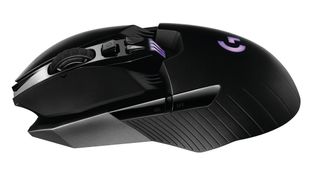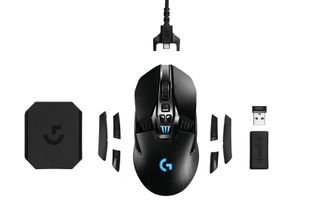Logitech's wireless, ambidextrous G900 Chaos Spectrum is its new flagship gaming mouse

Head over here to read my in-depth feature on how Logitech designed the G900 to prove wireless can outperform wired, with hands-on testing and data from Logitech's labs.
Nearly three years ago, Logitech’s gaming division started work on quite possibly its most challenging mouse design ever. Its last few mice have each offered a substantial new feature: the G502’s best-in-class sensor, the G402’s “Fusion” engine that uses an accelerometer to maintain accuracy at high movement speeds, the G302’s switch design that delivers fast, low-profile clicking. But this new mouse wanted to do all of those things in a chassis with the shape and weight of a mouse even pro gamers would use. And they wanted it to be wireless.
From what I’ve seen, Logitech pulled it off. The end result is the G900 Chaos Spectrum, a wireless ambidextrous mouse with the excellent PMW-3366 sensor (that scales up to 12,000 DPI), a brand new switch design for left and right click, and a freakishly light body for a wireless mouse. It weighs in at 107 grams, with a battery that will run for a continuous 24 hours of gaming time with the RGB lighting on, or top 30 with them disabled, according to Logitech’s numbers. Logitech’s mouse software has given me similar results while using the mouse, even with its report rate set to 1000 Hz (1ms).
The weight is the most striking thing about the G900. At 107 grams, it’s far lighter than competing wireless mice from Steelseries, Razer and Mad Catz, and Logitech’s older G602, my previous favorite wireless gaming mouse (153 grams with two AA batteries). The only lighter mouse I’ve used was a cheap Chinese import when testing wireless mice, but that mouse felt brittle and hollow, not precision engineered to cut out every possible gram. I like a light mouse, and the G900 almost feels too light for its size. Only a few mice aimed at competitive gamers, like Logitech’s G302/303 and Zowie’s mice, shave off enough weight to drop below the 100 gram mark. And those mice don’t have batteries in them.
My favorite touch of the G900 is its removable thumb buttons, which have a far better click feel (and are better shaped and better positioned) than the G303’s. That’s impressive for buttons attached via magnet, but they can easily be popped off the left or right side and replaced with a flat surface. This solves the biggest issue I’ve had with other ambidextrous mice: accidentally clicking a button with my pinky or uncomfortably altering my grip to avoid a misclick. The new pivot bar designed for the left- and right-click is similarly fantastic: the click action is even faster than the G302’s, and even when I’m clicking as fast as I can, it never feels mushy or bounces back too slowly to be ready for the next click.

From my hands-on time with the G900 so far, I haven’t noticed a single issue with its wireless performance, and switching between wireless and wired mode takes about five seconds. Logitech took journalists to its lab in Switzerland to learn about how they designed the G900’s wireless sensor and protocol to perform flawlessly in even the noisiest 2.4GHz environment, and show how they tested that performance against other mice. I previously visited the lab in 2014 and wrote about how gaming mice are built.
I haven’t spent enough time with the G900 yet to write a full review, but you can read my story on its wireless design here.
PC Gamer Newsletter
Sign up to get the best content of the week, and great gaming deals, as picked by the editors.
So far, the only drawback to the G900 I’ve experienced is its price. Like the Razer Mamba, Logitech plans to launch the G900 at a steep $150. Premium wireless doesn’t come cheap, but I hope to see the mouse drop to a lower price as Amazon works its algorithm magic. It’ll be available in April.

Wes has been covering games and hardware for more than 10 years, first at tech sites like The Wirecutter and Tested before joining the PC Gamer team in 2014. Wes plays a little bit of everything, but he'll always jump at the chance to cover emulation and Japanese games.
When he's not obsessively optimizing and re-optimizing a tangle of conveyor belts in Satisfactory (it's really becoming a problem), he's probably playing a 20-year-old Final Fantasy or some opaque ASCII roguelike. With a focus on writing and editing features, he seeks out personal stories and in-depth histories from the corners of PC gaming and its niche communities. 50% pizza by volume (deep dish, to be specific).
Most Popular






